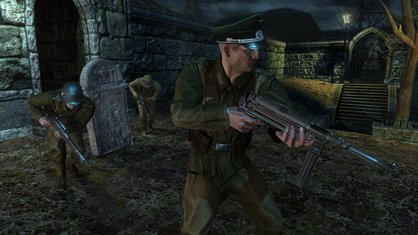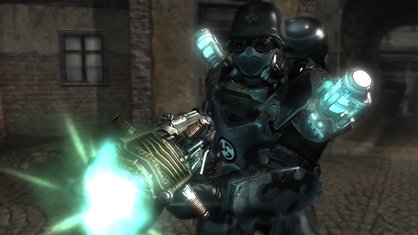Wolfenstein
Third time lucky for the Third Reich
So here’s the pitch. BJ Blazkowicz, hero of the original landmark game and Return to Castle Wolfenstein, is back. He’s still fighting the Nazis, and as usual, those Nazis are dabbling in the occult. Dabbling isn’t quite the word; more like abusing. The last time we met them, Himmler was planning to raise a zombie army to take over the world. A few months later, and the SS have discovered the ultimate occult power-source, something called the Black Sun (fact alert: a black sun symbol was used by the SS). But there’s a problem. To reach it, you’ll have to pass through dimensions, into an alternate reality overlaid on ours called the ‘shroud’.
Wolfenstein is the latest in a long, long list of collaborations between Raven and id Software; collaborations that have produced a flood of FPS games – shooters that practically templated PC gaming for nearly ten years. That relationship began, Kevin explains, “in Wisconsin. It was the first place that id set up as a developer,” near to where Raven had set up their own business. The developers quickly became friends. “But then winter happened,” says Kevin, “and id realised that Wisconson was cold. Id moved to Dallas, but the friendship remained.” The trust extends to id – a far smaller company than many realise – loaning their technology and franchises to their best friends. Wolfenstein follows Raven’s work on Quake 4, and, like Quake, is built on id’s ‘Tech 4’ – the code debuted in Doom 3.

But according to Kevin and Eric, Wolfenstein isn’t a corridor shooter. Nor is it a straightforward World War II action game. It does what the Call of Duty and Medal of Honour games do, topped by, as Kevin puts it, “a supernatural layer.” And then some. It takes place in an unnamed city, where SS units are experimenting with dark energy. Hell is breaking loose: partisan groups and Nazi storm troopers are in pitched battles for control. The city’s skyline is the important part: a maze of chimney pots and gothic tenements dominated by a stone steeple right in the center.
That brings us to our first major fact to take on board. Raven are paying excessive attention to the thrill of exploration, with semi-free-roaming allowed between story points. When an in-game character tells you to go to one point, you’ll be given multiple routes to it through the tightly controlled streets, your journey threatened by Nazi checkpoints and blockades. The straightforward route, heading into the melee until you’re surrounded by bodies, is obvious. Less obvious are the routes around. You can try clambering onto the rooftops to sneak or snipe your way past, or dive into the sewers to bypass them entirely. Exploration has other rewards: as in Wolfensteins of old, secret passages might reveal bullion and treasure. The difference this time: treasure can be spent on better weapons, and ‘shroud powers’.

In the demo we saw, Eric was cornered by a horde of Nazi storm troopers, using cover to advance up a road. With his AI friends – members of a resistance organisation – outflanked and outgunned, Eric retreated through an archway and up a flight of stone steps. There he had access to the roof. Ducking behind chimney pots, he was free to snipe away at the exposed soldiers, and drop grenades into their path. They were quickly scattered.
The weapons available are a mix of genre favourites: sub-machineguns and scopeless rifles, gatling guns and (ugh) mounted machineguns. But as the game progresses, and the scale of the Nazi occult meddling becomes clear, hi-tech impossibilities powered by ‘shroud energy’ become staples of combat. Take the electric death ray we saw stolen from an armour-plated soldier: it fires an electric beam of limited range, akin to Quake’s old lightning gun. Fire it, and it will evaporate flesh. It also tears through the barrels and crates that the troopers use for cover. It’s comic book hilarity through and through: screaming soldiers vanishing in a cloud of green smoke.
As is now traditional, the action is all pleasingly ragdolled and physics-ed up. Corpses tumble from their sniper positions like their strings have been cut. Running soldiers backflip when taken down with an artfully placed headshot. Clicking on men’s faces produces exactly the right pleasing reaction; that of painful whiplash. But this still points to tradition; the kind of game that any veteran FPS developer could make. Where’s the magic? “The thing that sets Wolfenstein apart from other shooters,” says Kevin, “is the strange voodoo that we can layer on top.” Which brings us back to the shroud, and another demo, later in Wolf’s story.
Sign up to the GamesRadar+ Newsletter
Weekly digests, tales from the communities you love, and more


